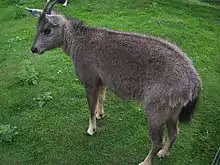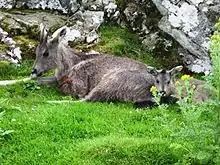Goral
The gorals are four species in the genus Nemorhaedus or Naemorhedus. They are small ungulates with a goat-like or antelope-like appearance.
| Gorals[1] | |
|---|---|
 | |
| Chinese goral, Nemorhaedus griseus | |
| Scientific classification | |
| Kingdom: | Animalia |
| Phylum: | Chordata |
| Class: | Mammalia |
| Order: | Artiodactyla |
| Family: | Bovidae |
| Subfamily: | Caprinae |
| Genus: | Naemorhedus Hamilton Smith, 1827 |
| Species | |
|
Naemorhedus goral | |
The original name is based on Latin nemor-haedus, from nemus, nemoris 'grove' and haedus 'little goat', but was misspelt Naemorhedus by Hamilton Smith (1827).[2][3]
Until recently, this genus also contained the serow species (now in genus Capricornis).[1] The name "goral" comes from an eastern Indian word for the Himalayan goral. The four species of gorals are:
| Image | Scientific name | Common Name | Distribution |
|---|---|---|---|
 | Naemorhedus goral | Himalayan goral (also known as ghural) | northwestern and northeastern India, as well as Nepal and Bhutan |
_-_ZOO_Plze%C5%88_01.jpg.webp) | Naemorhedus caudatus | long-tailed goral | eastern Russia and China through western Thailand and eastern Myanmar. A population has also been documented in the Demilitarized Zone on the Korean Peninsula |
| Naemorhedus baileyi | red goral | Yunnan province of China, to Tibet and northeastern India through northern Myanmar | |
 | Naemorhedus griseus | Chinese goral | Burma, China, India, Thailand, Vietnam, and possibly Laos. |
Gorals are often found on rocky hillsides at high elevations. Though their territories often coincide with those of the closely related serow, the goral will usually be found on higher, steeper slopes with less vegetation.
Gorals typically weigh 25–40 kilograms (55–88 lb) and are 80–130 centimetres (31–51 in) in length, with short, backward-facing horns. Coloration differs between species and individuals, but generally ranges from light gray to dark red-brown, with lighter patches on the chest, throat, and underside, and a dark stripe down the spine. They have woolly undercoats covered by longer, coarser hair, which helps to protect them in the cold areas where they are often found.
Though the groups share many similarities, gorals are stockier than antelopes and have broader, heavier hooves. Female gorals have four functional teats, while female goats and sheep have only two functional teats. Unlike serows, gorals have no working preorbital glands.
References
- Grubb, P. (2005). Wilson, D.E.; Reeder, D.M. (eds.). Mammal Species of the World: A Taxonomic and Geographic Reference (3rd ed.). Johns Hopkins University Press. ISBN 978-0-8018-8221-0. OCLC 62265494.
- Groves, C. P., and Grubb, P., 1985, Reclassification of the serows and gorals (Nemorhaedus: Bovidae). In The Biology and Management of Mountain Ungulates. Edited by S. Lovari. London: Croom Helm. pp. 45-50.
- Article 32.5.1. of International Commission on Zoological Nomenclature reads: "If there is in the original publication itself, without recourse to any external source of information, clear evidence of an inadvertent error, such as a lapsus calami or a copyist's or printer's error, it must be corrected."